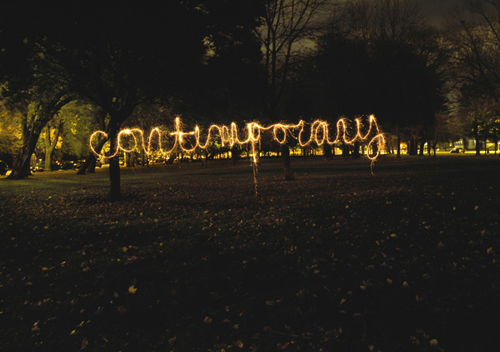
Jason Lazarus, Self portrait as an artist making something contemporary, 2004, 17 x 23 inches, archival ink jet.
Observing a curatorial echo chamber privileging appropriation and conceptualism, art critic Jerry Saltz made his own list of artists engaging the plastic arts after 1999. The writer selected nineteen women and fourteen men — thirty-three in total in keeping with the Younger Than Jesus triennial — none of whom have been in a Whitney Biennial (with three exceptions). We consider this a challenge and respond with our own list of artists. The selection reflects our desire for a better integration of conceptual and material-based practices. We also remained dedicated to showcasing artists emerging after 1999. This is the first in a three part post.
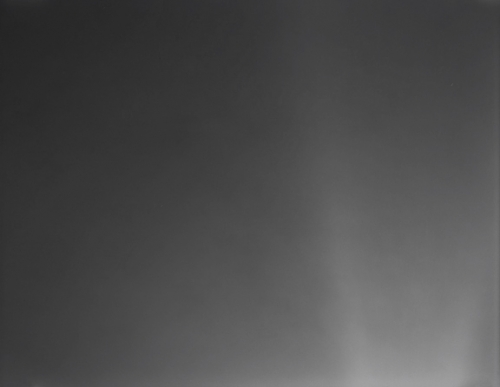
Jason Lazarus Barack Obama, Election Night Rally, Grant Park, Chicago, November 4, 2008, 2008, archival inkjet print, 57 x 80 inches, ed. 5. Image Andrew Rafacz Gallery
When Jason Lazarus graced our masthead two months ago, we described his practice as an understated subversive act. Challenging the immense field of documentary footage produced during Obama’s campaign, this photograph (capturing human sweat in the air) perfectly represents the excitement felt throughout the election. The apparent absence of a subject allows the viewer to fill in the narrative.
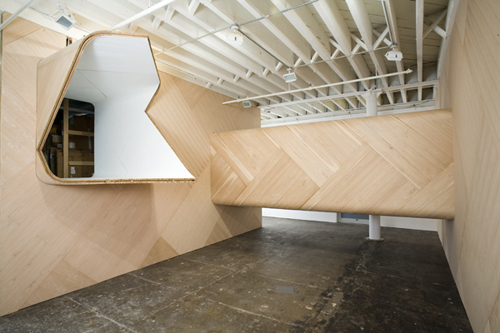
Sarah Oppenheimer, 554-5251, 2006, P.P.O.W. New York, NY
We saw Sarah Oppenheimer speak on a panel about Gordon Matta Clark last year at the Museum of Contemporary Art Chicago. Oppenheimer’s practice critically engages our perception of social space in the context of architectural history.
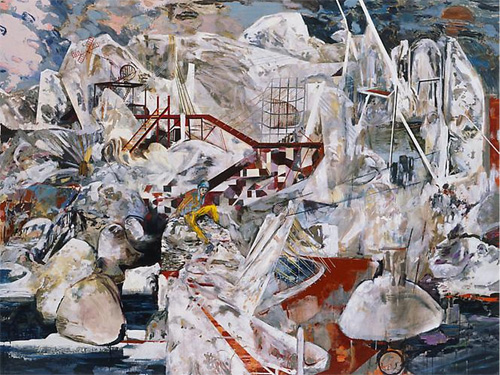
Hernan Bas, Mystery Bouf, (or the Kingdom After the Flood), 2009, Acrylic on linen over panel, 72 x 96 inches. Image via: Lehmann Maupin. Read the AFC Hernan Bas review.
A virtuoso painter, Hernan Bas investigates nascent gay sexuality. His paintings often reveal the awkward and unsettling stages in which his subjects become aware of their desires.

Saul Chernick, Hot Mess, 2008, ink on paper, 24.25 x 35.25 in. Courtesy Max Protetch Gallery. Saul Chernick was an Art Fag City Summer Emerging Artist in 2006.
Saul Chernick’s skillfully rendered drawings pair the style of a Dürer or Rembrandt etching with the line of Murakami. Exploring masculine identity,and Judeo-Christian beliefs, his compositions also challenge the Modernist grid.
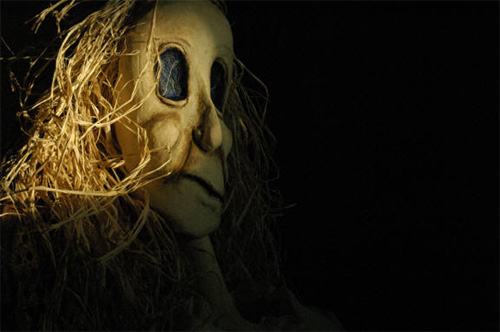
Brent Green, Carlin, 2006, video still. Edlin Gallery. Art Fag City review at The Reeler here.
To quote myself on Brent Green,
Paulina Hollers, an exhibition comprising three homemade animated videos and a tall spindly clock situated at the entrance of Bellwether Gallery, doesn’t appear at first to be so full of the unexpected. The work looks like a Tim Burton movie, it sounds like a combination of the spoken-word psychedelia of King Missile and the emo indie of Bright Eyes’ Conor Oberst (his collaborators are actually blues rock band Califone and noise rockers the Majik Markers), it reads like a Virginia Woolf novel or a T.S. Eliot poem — everything feels familiar in some way. Yet the success of this exhibition does not lie in the reinvention of the wheel, but rather that Green never confuses the maudlin with the poetic or inconsistency with falseness.
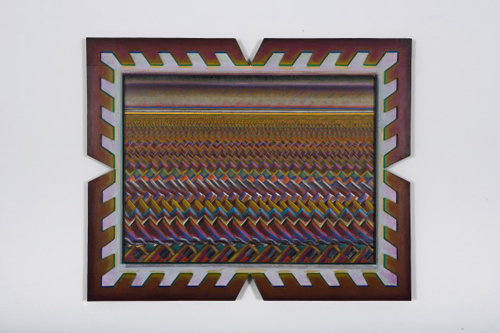
Zach Harris, Auditory Odyssey, 2007-2008, acrylic and wood, 25 7/8 x 21 x 1 1/8 inches. Courtesy Max Protetch Gallery.
Warring camps at Art Fag City debate the need for a Judy Chicago reference in this entry. Certainly the palette and patterning share some similarity, but Harris presents a far more sophisticated and accomplished body of work (though we acknowledge Chicago’s historical importance). The frame and field uniquely work together generating forms that often resemble 90’s video game graphics.

The new whippersnapper of art and tech! g comprises a lead ball, perched on the “g” key of a laptop computer, that creates a seemingly infinite Word document– until the computer crashes.
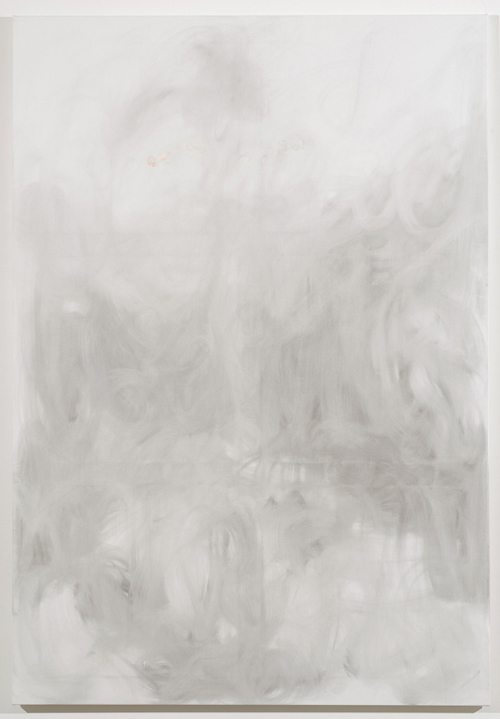
Richard Aldrich, Paint as Revealing Three Gestures: Psychological, Structural and Philosophical, 2006, Oil and wax on linen. Image: Marc Foxx Gallery
We issued mixed reviews on Aldrich’s exhibition at Bortolami this January, but the good outweighs the bad. Known for his heterogeneous practice, Aldrich slashes through canvases to expose the stretcher, plays with abstraction to obliquely reference the face and ruminates on the nature of painting. Aldrich often pairs his paintings with pithy titles that point to the sentiment of his work.
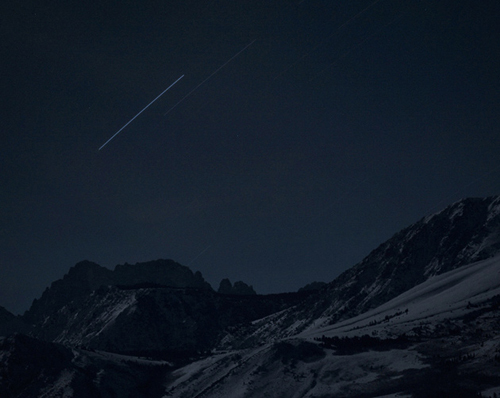
Trevor Paglen, Four Geostationary Satellites Above the Sierra Nevada, 48 x 60 inches, C-Print, 2007. Bellwether Gallery. Art Fag City reflects on Trevor Paglen’s talk at the New Museum.
“Secrecy, from the get go represents a contradiction”, Trevor Paglen told the New Museum last year. “What you’re trying to do with secrecy is to make things disappear, now the problem that you have is that the world is made up of stuff, and one of the physical properties of matter is that it reflects light, so right there you have this original contradiction. I think that there’s a whole number of contradictions that are in this world, and if you can find those contradictions, you can start to develop this visual vocabulary, this way of trying to come to terms with this secret world.”
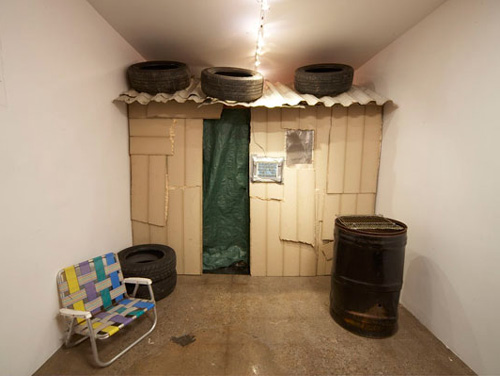
Lisa Kirk, Maison des Cartes Lifestyle installation shot. Courtesy Invisible Exports.
We were lucky enough to receive a guided tour of Maison des Cartes at Invisible Exports, courtesy of a charismatic actress Lisa Kirk found via Craigslist. This Büchel-esque installation brands Maison des Cartes (usually shortened to May-Zone) time shares at the Brooklyn Navy Yard so successfully that the absurdity of the performance reveals the force of the pitch.
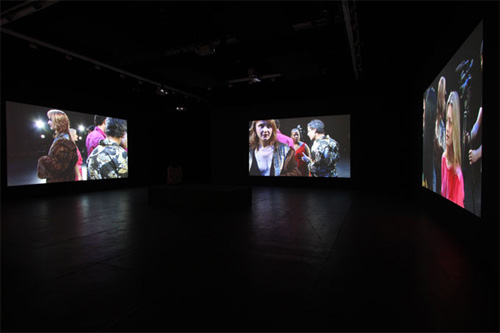
Alix Pearlstein After the Fall, 2008. 4 channel HDV installation, 20:48. Installation shot of performance at The Kitchen.
So rarely do we see work engaging the stage and abstract theatrical performance. Consequently, Alix Pearlstein is an obvious choice for our list. Her work doesn’t produce a cohesive narrative thread, so it can be difficult to describe to readers who haven’t seen it, but there’s a physicality to its engagement that’s intensely satisfying.


{ 27 comments }
Oh boy here we go. First Fischl, now Saltz. Interesting (as I tug my nonexistent goatee), well you know as Saltz said himself – how did he get to be an art critic? He just said “well I’ll be the art the critic.” (from that debate about the stock vs the art market). And that was that. Anyway, let’s see how this unfolds. In this battle I think you certainly have the edge.
-Casey
Oh boy here we go. First Fischl, now Saltz. Interesting (as I tug my nonexistent goatee), well you know as Saltz said himself – how did he get to be an art critic? He just said “well I’ll be the art the critic.” (from that debate about the stock vs the art market). And that was that. Anyway, let’s see how this unfolds. In this battle I think you certainly have the edge.
-Casey
awesome, thanks for doing this; can’t wait to see the rest.
awesome, thanks for doing this; can’t wait to see the rest.
awesome, thanks for doing this; can’t wait to see the rest.
I agree with your premise…pretty great stuff.
I agree with your premise…pretty great stuff.
good choices. looking forward to more.
good choices. looking forward to more.
Paddy– great list! I can’t wait to see everything. I especially like the Brent Green and Jack Strange inclusion.
One thing that I did think of, though, is about the discussion of narrative in the Jason Lazarus photograph. Instead of the subject’s absence “allow[ing] the viewer to fill in the narrative,” I read the photo as actually doing somewhat the opposite. Because the title refers so specifically to a moment in time that is SO widely recognized and remembered (Obama Election Night Rally), I think that the abstraction of the picture actually is weighed underneath the imposed narrative. Certainly, the first thing you see that is striking is the texture of the photography– the subtle shifts in tone and value. And then you read the title, and it’s a big “huh” moment, and you go back and look at the abstraction of the photo. That’s what’s striking– since Lazarus is challenging the huge amount of documentary photograph that exists around the election, he attempts to offer a different side of the event… but it’s still a side of THAT event.
I think because he chooses a time that is so widely remembered, he actually imposes a narrative on the photograph. Instead of titling it “Chicago, Night Rally,” or something slightly more obscure, he selects the very restrictive title of the event rally. Thus, I think the title actually forces the viewer to read the implied narrative of the photograph. I don’t think it’s as open or “allows” as much– instead, I read it as being a fairly contained photograph.
Anyway, just some feedback. I can’t wait to see part two!
Paddy– great list! I can’t wait to see everything. I especially like the Brent Green and Jack Strange inclusion.
One thing that I did think of, though, is about the discussion of narrative in the Jason Lazarus photograph. Instead of the subject’s absence “allow[ing] the viewer to fill in the narrative,” I read the photo as actually doing somewhat the opposite. Because the title refers so specifically to a moment in time that is SO widely recognized and remembered (Obama Election Night Rally), I think that the abstraction of the picture actually is weighed underneath the imposed narrative. Certainly, the first thing you see that is striking is the texture of the photography– the subtle shifts in tone and value. And then you read the title, and it’s a big “huh” moment, and you go back and look at the abstraction of the photo. That’s what’s striking– since Lazarus is challenging the huge amount of documentary photograph that exists around the election, he attempts to offer a different side of the event… but it’s still a side of THAT event.
I think because he chooses a time that is so widely remembered, he actually imposes a narrative on the photograph. Instead of titling it “Chicago, Night Rally,” or something slightly more obscure, he selects the very restrictive title of the event rally. Thus, I think the title actually forces the viewer to read the implied narrative of the photograph. I don’t think it’s as open or “allows” as much– instead, I read it as being a fairly contained photograph.
Anyway, just some feedback. I can’t wait to see part two!
Paddy– great list! I can’t wait to see everything. I especially like the Brent Green and Jack Strange inclusion.
One thing that I did think of, though, is about the discussion of narrative in the Jason Lazarus photograph. Instead of the subject’s absence “allow[ing] the viewer to fill in the narrative,” I read the photo as actually doing somewhat the opposite. Because the title refers so specifically to a moment in time that is SO widely recognized and remembered (Obama Election Night Rally), I think that the abstraction of the picture actually is weighed underneath the imposed narrative. Certainly, the first thing you see that is striking is the texture of the photography– the subtle shifts in tone and value. And then you read the title, and it’s a big “huh” moment, and you go back and look at the abstraction of the photo. That’s what’s striking– since Lazarus is challenging the huge amount of documentary photograph that exists around the election, he attempts to offer a different side of the event… but it’s still a side of THAT event.
I think because he chooses a time that is so widely remembered, he actually imposes a narrative on the photograph. Instead of titling it “Chicago, Night Rally,” or something slightly more obscure, he selects the very restrictive title of the event rally. Thus, I think the title actually forces the viewer to read the implied narrative of the photograph. I don’t think it’s as open or “allows” as much– instead, I read it as being a fairly contained photograph.
Anyway, just some feedback. I can’t wait to see part two!
Glad to see Sarah Oppenheimer on here.
Also, in response to Peter, I don’t necessarily think that “allow[ing] the viewer to fill in the narrative” implies a narrative separate from the one indicated by the title; I read Paddy/Karen’s text as describing a process of mentally filling in the lack of an explicit visual narrative in Lazarus’ photograph with the plethora of available images of the event that exist. In this sense, it forces the viewer to actively conjure up the documentation of the event to “complete” the picture while simultaneously commenting on the way we treat significant events and the desire to have some kind of physical evidence in the form of an image.
Glad to see Sarah Oppenheimer on here.
Also, in response to Peter, I don’t necessarily think that “allow[ing] the viewer to fill in the narrative” implies a narrative separate from the one indicated by the title; I read Paddy/Karen’s text as describing a process of mentally filling in the lack of an explicit visual narrative in Lazarus’ photograph with the plethora of available images of the event that exist. In this sense, it forces the viewer to actively conjure up the documentation of the event to “complete” the picture while simultaneously commenting on the way we treat significant events and the desire to have some kind of physical evidence in the form of an image.
Glad to see Sarah Oppenheimer on here.
Also, in response to Peter, I don’t necessarily think that “allow[ing] the viewer to fill in the narrative” implies a narrative separate from the one indicated by the title; I read Paddy/Karen’s text as describing a process of mentally filling in the lack of an explicit visual narrative in Lazarus’ photograph with the plethora of available images of the event that exist. In this sense, it forces the viewer to actively conjure up the documentation of the event to “complete” the picture while simultaneously commenting on the way we treat significant events and the desire to have some kind of physical evidence in the form of an image.
Absolutely love the print “Four Geostationary Satellites Above the Sierra Nevada”. Its moving and very mysterious. I have a great appreciation of darker and more dramatic art pieces. I would definately hang a print of this on my wall. 🙂
Absolutely love the print “Four Geostationary Satellites Above the Sierra Nevada”. Its moving and very mysterious. I have a great appreciation of darker and more dramatic art pieces. I would definately hang a print of this on my wall. 🙂
Absolutely love the print “Four Geostationary Satellites Above the Sierra Nevada”. Its moving and very mysterious. I have a great appreciation of darker and more dramatic art pieces. I would definately hang a print of this on my wall. 🙂
Hey Peter,
Just a note that Karen co-authored the post. She was just as much a part of writing the post as me.
Hey Peter,
Just a note that Karen co-authored the post. She was just as much a part of writing the post as me.
Hey Peter,
Just a note that Karen co-authored the post. She was just as much a part of writing the post as me.
@Paddy– My mistake! I listed Karen when I linked this to Facebook, but forgot to mention her in my previous comment. Congrats to Karen, for sure! It’s an impressive list, so far. And I echo Rachel in appreciating the Oppenheimer inclusion.
@Rachel– Yeah, I definitely hear you on that– especially since it seems that Lazarus is really taking issue with the the mass of footage already available from the election. I like your last point a lot, actually, about commenting on how we memorialize events through images. I just was really more taking issue with the phrasing, which to me indicates a freedom to do so– an openness to the image that “allows” you but does not compel you to complete the image. I think Lazarus’ photograph inhibits the allowance aspect by actually impelling the narrative. You’re not going to read his photograph the same way after “getting” the title. It’s sort of a forced constraint, which I think actually then speaks to the more general nature of captioning and abstraction in photography (I’m thinking here of even beginning back to W. H. Fox Talbot, Le Gray, Weston, Tillmans, etc.).
I think Lazarus’ photograph does exactly what you’re describing, Rachel– comment on how we treat significant events, but in terms of Paddy/Karen’s phrasing, I don’t think the photograph allows anything, because that then denotes a certain freedom to choose between filling in/not filling in. I just read the interplay between title and abstraction in the image as providing a tension that forces a certain reading, not allowing it.
@Paddy– My mistake! I listed Karen when I linked this to Facebook, but forgot to mention her in my previous comment. Congrats to Karen, for sure! It’s an impressive list, so far. And I echo Rachel in appreciating the Oppenheimer inclusion.
@Rachel– Yeah, I definitely hear you on that– especially since it seems that Lazarus is really taking issue with the the mass of footage already available from the election. I like your last point a lot, actually, about commenting on how we memorialize events through images. I just was really more taking issue with the phrasing, which to me indicates a freedom to do so– an openness to the image that “allows” you but does not compel you to complete the image. I think Lazarus’ photograph inhibits the allowance aspect by actually impelling the narrative. You’re not going to read his photograph the same way after “getting” the title. It’s sort of a forced constraint, which I think actually then speaks to the more general nature of captioning and abstraction in photography (I’m thinking here of even beginning back to W. H. Fox Talbot, Le Gray, Weston, Tillmans, etc.).
I think Lazarus’ photograph does exactly what you’re describing, Rachel– comment on how we treat significant events, but in terms of Paddy/Karen’s phrasing, I don’t think the photograph allows anything, because that then denotes a certain freedom to choose between filling in/not filling in. I just read the interplay between title and abstraction in the image as providing a tension that forces a certain reading, not allowing it.
@Paddy– My mistake! I listed Karen when I linked this to Facebook, but forgot to mention her in my previous comment. Congrats to Karen, for sure! It’s an impressive list, so far. And I echo Rachel in appreciating the Oppenheimer inclusion.
@Rachel– Yeah, I definitely hear you on that– especially since it seems that Lazarus is really taking issue with the the mass of footage already available from the election. I like your last point a lot, actually, about commenting on how we memorialize events through images. I just was really more taking issue with the phrasing, which to me indicates a freedom to do so– an openness to the image that “allows” you but does not compel you to complete the image. I think Lazarus’ photograph inhibits the allowance aspect by actually impelling the narrative. You’re not going to read his photograph the same way after “getting” the title. It’s sort of a forced constraint, which I think actually then speaks to the more general nature of captioning and abstraction in photography (I’m thinking here of even beginning back to W. H. Fox Talbot, Le Gray, Weston, Tillmans, etc.).
I think Lazarus’ photograph does exactly what you’re describing, Rachel– comment on how we treat significant events, but in terms of Paddy/Karen’s phrasing, I don’t think the photograph allows anything, because that then denotes a certain freedom to choose between filling in/not filling in. I just read the interplay between title and abstraction in the image as providing a tension that forces a certain reading, not allowing it.
re Alix Pearlstein and art in general
i’ve found lately that when i like something i’ve often resorted to calling the work “unsatisfying.” of course, satisfying is related to unsatisfying and the unsatisfying quality i mention is, in a sense, satisfying. and i’ve never seen alix pearlstein’s work, so. just an observation. recent work that i’ve seen that i liked but found satisfying, which made it, ultimately, not that great, william powhida. satisfying works, shows, such as powhida’s are super, but then their resonance quickly disappears and becomes something like information seen, more literal in this case, information read.
re Alix Pearlstein and art in general
i’ve found lately that when i like something i’ve often resorted to calling the work “unsatisfying.” of course, satisfying is related to unsatisfying and the unsatisfying quality i mention is, in a sense, satisfying. and i’ve never seen alix pearlstein’s work, so. just an observation. recent work that i’ve seen that i liked but found satisfying, which made it, ultimately, not that great, william powhida. satisfying works, shows, such as powhida’s are super, but then their resonance quickly disappears and becomes something like information seen, more literal in this case, information read.
re Alix Pearlstein and art in general
i’ve found lately that when i like something i’ve often resorted to calling the work “unsatisfying.” of course, satisfying is related to unsatisfying and the unsatisfying quality i mention is, in a sense, satisfying. and i’ve never seen alix pearlstein’s work, so. just an observation. recent work that i’ve seen that i liked but found satisfying, which made it, ultimately, not that great, william powhida. satisfying works, shows, such as powhida’s are super, but then their resonance quickly disappears and becomes something like information seen, more literal in this case, information read.
Comments on this entry are closed.